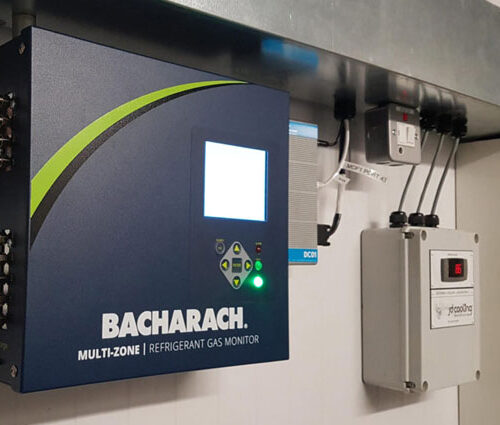
In recent years, the global supermarket industry has seen a significant shift towards sustainability and environmental responsibility. Supermarkets, with their extensive refrigeration systems, play a vital role in this transition. However, these systems can generate refrigerant leaks, posing potential environmental hazards and financial losses. In this blog, we will delve into the importance of refrigerant leak detection for supermarkets, explore regulations, focus on common supermarket refrigerants, and discuss leak detection solutions.
Environmental Impact
Hydrofluorocarbon (HFC) refrigerants, commonly used in supermarkets1, are potent greenhouse gases that significantly contribute to climate change2. Rapidly detecting and repairing leaks can minimize the release of these substances into the atmosphere, helping to reduce the supermarket’s overall carbon footprint and environmental impact.
Regulatory Compliance
Many countries have strict regulations governing the use and emission of refrigerants. Supermarkets may be required to adhere to these regulations to avoid fines and legal consequences. Rapid leak detection can help supermarkets remain compliant with these laws, which in turn helps supermarkets maintain their reputation and financial stability.
In Europe, regulations such as the F-Gas Regulation (EU) No 573/2024 set forth rules regarding the use and management of fluorinated gases, including refrigerants. This regulation mandates regular leak checks depending on the quantity of refrigerant from less than 50 tonnes of CO2 equivalent of fluorinated greenhouse gases to over 500 tonnes (Chapter II, Article 5 “Leak Checks”, Paragraph 6)3. Similar regulations are prevalent worldwide, reflecting the global commitment to environmental preservation.
Regulations in the United States promulgated by the Environmental Protection Agency (EPA) under Section 608 of the Clean Air Act apply to organizations involved in refrigeration and air conditioning. The regulations address the safe handling of refrigerants, with the goal of minimizing emissions and environmental harm. Compliance involves certification for technicians handling refrigerants, proper leak repair, and responsible disposal (EPA regulations (40 CFR Part 82, Subpart F) under Section 608 of the Clean Air Act)4.
GreenChill is an example of a food retail initiative led by the EPA. The initiative focuses on helping food retail organizations adopt eco-friendly refrigeration practices. To comply, retailers transition to low-global warming potential refrigerants, minimize refrigerant usage through regular leak detection and repairs, and embrace energy-efficient technologies5.
Energy Efficiency
Refrigerant leaks can decrease system efficiency by forcing compressors to work harder to maintain the desired temperature. This increased workload results in higher energy consumption, leading to inflated energy bills. Quick detection and repair of a leak helps the refrigeration system operate at optimal efficiency, saving energy and costs in the long run.
Preservation of Goods
Supermarkets rely on precise temperature control to keep perishable goods fresh. A refrigerant leak can compromise this control, leading to inconsistent temperatures that can spoil food and other products. Rapid detection helps prevent such situations, enabling supermarkets to better safeguard the quality and safety of the merchandise.
Financial Savings
Detecting and repairing leaks promptly helps prevent the loss of refrigerants, which are expensive to replace. It can also reduce the need for costly system repairs by avoiding potential damage to the refrigeration system itself. By addressing leaks swiftly, supermarkets can save significant amounts of money in both refrigerant replacement and system maintenance costs.
Reputation Management
With growing awareness about environmental issues, consumers are becoming increasingly eco-conscious. Supermarkets that demonstrate a commitment to environmental responsibility by promptly addressing leaks and reducing their greenhouse gas emissions can enhance their public image. Many customers may prefer to support and to place their trust in businesses that prioritize sustainability and environmental conservation.
Refrigerant Leak Detection Solutions
As we’ve discussed, finding refrigerant leaks quickly can help minimize environmental harm, satisfy regulatory compliance, enhance energy efficiency, preserve goods, save money, and maintain a positive reputation. Supermarkets that prioritize rapid leak detection can contribute to a more sustainable future while also benefiting their bottom line and customer relations. There are several solutions that support rapid leak detection, notification, and consequential repairs while assisting in minimizing refrigerant emissions. These solutions can be broken down into three different categories: background monitoring, localized leak detection, and integrated IoT solutions to improve efficiencies.
Background monitoring
Background monitoring solutions for detecting refrigerant leaks in supermarkets involve automated systems that operate continuously in the background, providing ongoing surveillance of refrigeration systems. Diffusion and aspirated systems are commonly used in supermarkets. Diffusion monitoring systems operate by allowing gases to naturally diffuse into sensors, while aspirated monitoring systems actively draw air samples through a network of pipes and sensors for detection.
Diffusion-Based Detectors:
Pros:
- Simplicity: Diffusion-based detectors are relatively simple devices. They operate by allowing refrigerant gas to diffuse through a membrane and into a sensing element. When the gas concentration reaches a certain level, an alarm is triggered.
- Cost-Effectiveness: These detectors are often more affordable than complex aspirated systems, making them a cost-effective choice, especially for smaller supermarkets with budget constraints.
- Low Maintenance: Diffusion-based detectors generally require minimal maintenance. They have fewer moving parts and do not rely on pumps or aspirators, reducing the need for regular servicing beyond the required annual calibration.
Cons:
- Limited Detection Range: Diffusion-based detectors might have limitations in detecting leaks in larger spaces or areas with poor air circulation. They may be more suitable for localized leak detection rather than comprehensive coverage of a large supermarket.
- Response Time: The response time of diffusion-based detectors can be slower compared to aspirated systems. This delay might not be optimal for preventing loss of refrigerant charge in a rapid leak.
Aspirated Monitoring Systems:
Pros:
- High Sensitivity: Aspirated systems, also known as active air sampling systems, can detect even very low concentrations of refrigerant gases. They use a pump to continuously aspirate air samples, offering high sensitivity and allowing a quick response to leaks.
- Wide Coverage: Aspirated systems are designed to cover larger areas. They use a network of sampling points, allowing them to monitor extensive spaces effectively. This feature may make them suitable for large supermarkets with complex refrigeration systems.
- Remote Sampling: Aspirated systems can sample air from various locations, which can be particularly useful in supermarkets where refrigeration units might be dispersed across different sections of the store.
Cons:
- Complexity: Aspirated systems are more complex than diffusion-based detectors. They may require careful installation, calibration, and regular maintenance to ensure optimal performance.
- Higher Cost: Aspirated systems tend to be more expensive upfront due to their complexity and capabilities. However, their advanced features might justify the higher cost for larger supermarkets with extensive refrigeration needs.
Diffusion or Aspirated background detection?
For smaller supermarkets with limited space and straightforward refrigeration setups, diffusion-based detectors could be a suitable and cost-effective choice. However, for larger supermarkets with complex refrigeration systems and a need for comprehensive coverage and high sensitivity, aspirated monitoring systems may be the preferred option despite their higher initial cost and installation complexity. The choice between these systems ultimately depends on the specific requirements, budget, and size of the supermarket.
Localized leak detection
Once a refrigerant leak is detected using the adopted background monitoring solution, it’s desirable to pinpoint the leak itself so an effective repair can be made. Portable electronic devices and ultrasonic detectors are commonly used to pinpoint the leak.
Portable Electronic Leak Detectors:
Portable, handheld electronic leak detectors can detect a wide range of gases, including refrigerants. Technicians can move these devices close to potential leak points, and the detector is designed to alarm when it detects gas concentrations above a certain threshold. They are commonly used in HVAC and refrigeration systems.
Ultrasonic leak detectors:
Ultrasonic leak detectors are designed to detect the sound generated by a leak. They convert the ultrasonic sound waves into audible signals, helping technicians pinpoint the exact location of the leak. These detectors can be beneficial in detecting leaks in compressed air systems and vacuum systems.
Integrated IoT solutions
Cloud-based monitoring solutions collect data from sensors and devices installed in the supermarket’s refrigeration systems or external monitors. These solutions offer remote access, allowing authorized personnel to monitor the system’s status from almost anywhere. Cloud platforms often come with analytics tools that help provide insights into system performance and trends.
Building Management System (BMS) software can integrate refrigerant monitoring into its functions. A BMS continuously monitors various building systems, including refrigeration. It may provide real-time data and can be configured to send alerts via email, SMS, or in-app notifications when leaks are detected.
Conclusion
As supermarkets navigate the complexities of environmental responsibility and compliance, investing in advanced refrigerant leak detection solutions is a wise choice. By adopting eco-friendly refrigerants and leveraging cutting-edge detection technology, supermarkets can help ensure both environmental preservation and operational efficiency. Moreover, staying compliant with global regulations not only helps to protect our planet but can also foster a positive image for the supermarket industry. Embracing these changes today paves the way for a sustainable tomorrow.
Sources:
1. Environmental Investigation Agency (EIA), “Leaking Havoc: Exposing Your Supermarket’s Invisible Climate Pollution” (https://www.climatefriendlysupermarkets.org/leaking-havoc)
2. United Nations Development Programme (UNDP), “Kigali Amendment”, (https://www.undp.org/chemicals-waste/montreal-protocol/kigali-amendment)
3. Regulation (EU) 2024/573 of the European Parliament and of the Council of 7 February 2024 on fluorinated greenhouse gases, amending Directive (EU) 2019/1937 and repealing Regulation (EU) No 517/2014, (see Chapter II, Article 5, “Leak Checks”)
4. EPA regulations (40 CFR Part 82, Subpart F ) under Section 608 of the Clean Air Act, (https://www.epa.gov/section608/section-608-technician-certification-requirements)
5. GreenChill, “Keeping Cool for Fifteen Years”, (https://www.epa.gov/system/files/documents/2022-09/GreenChill-Keeping-Cool-for-15-Years-2022_1.pdf)







